Country guides

Things to do in Spain
Spain's many attractions and the journeys between them are infused with the warm welcome of its diverse people. Holidays here should be slow, with room for spontaneity amid the laidback lifestyle that Spaniards have perfected.
The wealth of things to see and do is such that the top attractions in Spain are whole cities, towns, and islands, and a single holiday can barely scratch the surface of what this country has to offer. It's often best to plan an itinerary around a single city or region.
Toledo is famous for its Roman architecture and ancient history, while Santiago de Compostela bursts with religious significance and art. Cordoba entrances visitors with the medieval charm of the Mezquita, while Barcelona is home to Gaudi and almost anything a tourist could want. Madrid is the capital and ideal for a cosmopolitan Spanish experience, while Grenada contains mountains, tradition, and architecture.
Partygoers will look no further than Ibiza, and Bilbao is a hub of industrial creativity and boasts the Guggenheim Museum. Both Mallorca and Tenerife enjoy spectacular beaches and stunning landscapes, as does San Sebastian along with its good food. Lastly, Seville offers fun after dark and a wealth of history.

Granada and the Alhambra
Granada is a high altitude city of romance and folklore that boasts one of the most popular tourist attractions in Spain: the Alhambra. A palace-fortress built up between the 9th a…
Granada and the Alhambra
Granada is a high altitude city of romance and folklore that boasts one of the most popular tourist attractions in Spain: the Alhambra. A palace-fortress built up between the 9th and 16th centuries, the Alhambra is the most important and spectacular piece of Moorish architecture in Spain. Set against the backdrop of the Sierra Nevada Mountains, the huge complex includes the Summer Palace with its fountains and gardens, the Palacios Nazaries with its intricate ornamentation, and a hilltop fortress. The queue to get into this UNESCO World Heritage Site gets ridiculously long and tickets should be booked online and weeks in advance to avoid disappointment. At least one full day is required to really explore the vast complex.

The Prado
Renowned as one of Madrid's most famous attractions and one of the world's greatest art galleries, the 19th-century Prado Museum has more than 7,000 paintings that include masterpi…
The Prado
Renowned as one of Madrid's most famous attractions and one of the world's greatest art galleries, the 19th-century Prado Museum has more than 7,000 paintings that include masterpieces by Fra Angelico, Botticelli, El Bosco, Titian, Rembrandt, and Velazquez. The museum began as a Royal collection, which succeeding dynasties have added to. The collection naturally focuses on the Spanish masters, particularly Goya, whose exhibited works fascinatingly follow the development of his painting from the sun-soaked early scenes of joyful festivities to the grim madness characterising his 'black period'. Art lovers will find that the Prado has few equals.
Website www.museodelprado.es

Reina Sofia National Art Centre Museum
One of Madrid's famed art galleries, the Reina Sofia is dedicated to 20th century Spanish art, having been designed to give Spain a museum to equal France's Pompidou Centre and Lon…
Reina Sofia National Art Centre Museum
One of Madrid's famed art galleries, the Reina Sofia is dedicated to 20th century Spanish art, having been designed to give Spain a museum to equal France's Pompidou Centre and London's Tate Gallery. The museum was opened by Queen Sofia in 1986 and is housed in the former Hospital de San Carlos. The artworks displayed here include those of Spanish masters Juan Gris, Julio Gonzalez, Salvador Dali, Equipo Cronica, Gerardo Rueda, Joan Miro, and Pablo Picasso, among others, and there are also international artists on display. The star attraction of the museum is Picasso's controversial Guernica, which depicts the Nazi bombing of the Basque town in 1937 in support of Franco's cause in the Spanish Civil War.
Website www.museoreinasofia.es
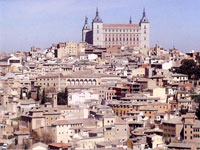
Toledo
The magnificent hilltop city of Toledo, about 43 miles (70km) southwest of Madrid, was immortalised by Spain's renowned artistic genius El Greco in a cityscape that currently hangs…
Toledo
The magnificent hilltop city of Toledo, about 43 miles (70km) southwest of Madrid, was immortalised by Spain's renowned artistic genius El Greco in a cityscape that currently hangs in the Metropolitan Museum of Art in New York. The city has changed little since El Greco captured it on canvas in 1597, with its golden spires and Gothic buildings spreading across the Tagus River Gorge, and overlooking the plains of New Castille. Toledo was established by the Romans in about 192 BC and some Roman ruins are still visible outside the city walls. The ancient city was later the capital of Visigoth Spain in the 5th and 6th centuries and as time passed Muslim, Jewish and Christian communities all left their mark on the city's rich architectural heritage. Toledo is a UNESCO World Heritage Site.
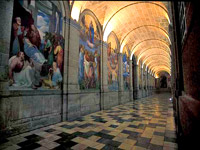
Monastery of San Lorenzo de El Escorial
Topped by four spiral towers, the huge granite edifice of the monastery is a foreboding sight in the town of San Lorenzo de El Escorial. About 30 miles (50km) northwest of Madrid, …
Monastery of San Lorenzo de El Escorial
Topped by four spiral towers, the huge granite edifice of the monastery is a foreboding sight in the town of San Lorenzo de El Escorial. About 30 miles (50km) northwest of Madrid, El Escorial was a marriage of Roman Catholic power and Spanish. Once a monastery and a royal palace, this UNESCO World Heritage Site was completed in 1584 and took almost 21 years to build. The complex was built by Philip II as a memorial to his father, Charles V, as a summer residence and as a final resting place for Spanish royalty. The complex is similar to the Alcazar of Seville and the Alhambra of Granada in layout, but the architectural style and decor are far more austere.
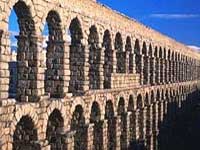
Segovia
Lying on a slope of the Guadarrama Mountains with the confluence of the Eresma and Clamores Rivers below, the ancient town of Segovia is a delightful taste of the glorious past of …
Segovia
Lying on a slope of the Guadarrama Mountains with the confluence of the Eresma and Clamores Rivers below, the ancient town of Segovia is a delightful taste of the glorious past of Castile in central Spain. Segovia is 54 miles (91km) northwest of Madrid and is well worth visiting for its reputation as being the most beautiful city in Spain; the journey only takes about an hour by bus (and only 30 minutes by high speed train), making it the perfect excursion. The ancient town has been awarded a place on the UNESCO World Heritage list and is a joy for photographers, with its historic pedigree proudly displayed. The ancient Romans turned the town into a military base, leaving behind Segovia's famous aqueduct.
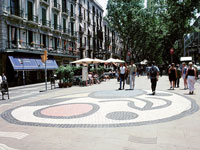
La Rambla
Arguably the most famous street in Europe, the wide tree-lined boulevard known as La Rambla (or Las Ramblas) is a long continuous pedestrian avenue that technically changes names f…
La Rambla
Arguably the most famous street in Europe, the wide tree-lined boulevard known as La Rambla (or Las Ramblas) is a long continuous pedestrian avenue that technically changes names five times as it cuts through Barcelona's Old Town, the Barri Gotic, from the Placa Catalunya to the city's port. It's lined with cafes, restaurants, and shops, usually thronged with leisurely walkers enjoying the sights and sounds. The sprawling marriage of nature and creative architecture and ornamentation that is Gaudi's Guell Park is a must. The pretty square of Placa Reial, enclosed by impressive buildings and promising some fantastic restaurants and nightclubs, is a popular social venue and sometimes hosts concerts and live performances.
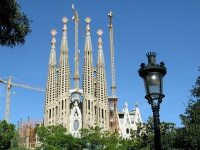
La Sagrada Familia
Designed by modernist architect Antoni Gaudi, the bizarre Sagrada Família is one of Catalonia's most intriguing landmarks. Building started in 1882, but it remains unfinished and …
La Sagrada Familia
Designed by modernist architect Antoni Gaudi, the bizarre Sagrada Família is one of Catalonia's most intriguing landmarks. Building started in 1882, but it remains unfinished and an object of controversy. Gaudi worked on what was considered his masterpiece until his death in 1926. The structure displays his characteristic Art Nouveau style and creates a unique interpretation of the Gothic architectural tradition. Gaudi's plans for the completed church were mostly destroyed during the Spanish Civil War and those leftover have been disputed since. The extraordinary building is a UNESCO World Heritage Site, and is fascinating even to those who don't find it beautiful. The church has been consecrated and is used for religious services.
Website www.sagradafamilia.org
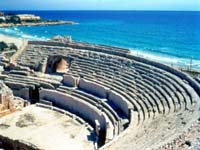
Tarragona
The Costa Dorada's main city, Tarragona, was originally built on a rocky bluff and can trace its roots back to 218 BC, when it was founded by the ancient Romans as a military base.…
Tarragona
The Costa Dorada's main city, Tarragona, was originally built on a rocky bluff and can trace its roots back to 218 BC, when it was founded by the ancient Romans as a military base. Impressive vestiges of its ancient past still remain in the form of ruins of the Roman amphitheatre, aqueduct, forum and other buildings situated on the Paseo Arqueologico (Archaeological Promenade), which leads to some panoramic viewpoints. A wide boulevard called the Rambla Nova represents the modern main street outside the old city walls. A popular outing for visitors is to explore the old harbour, known as El Serrallo, and watch the fishing boats arrive and auction their catch.
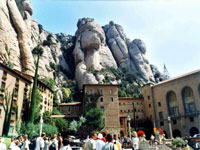
Montserrat
One of the most visited sites in Catalonia is the monastery at Montserrat, which is 35 miles (56km) northwest of Barcelona. The monastery is surrounded by strange rocky crags and c…
Montserrat
One of the most visited sites in Catalonia is the monastery at Montserrat, which is 35 miles (56km) northwest of Barcelona. The monastery is surrounded by strange rocky crags and caves, and was founded in 1025 to celebrate local visions of the Virgin Mary. It has become one of the most important pilgrimage sites in Spain, sitting atop a 4,000-foot (1,200m) high mountain and housing about 80 monks. Its main claim to fame is a 12th-century Romanesque wooden sculpture of a black Virgin Mary, known as La Moreneta, which thousands come here to see and touch. There's lots to see at Montserrat, which has a fascinating museum housing masterpieces by artists such as Caravaggio and Picasso.
Website www.montserratvisita.com/en/index.html
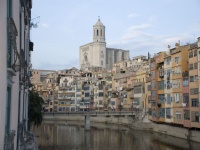
Girona
The city of Girona, on the route from the Pyrenees to Barcelona, is one of the most important historical sites in Spain, and was founded by the Romans and later turned into a Moori…
Girona
The city of Girona, on the route from the Pyrenees to Barcelona, is one of the most important historical sites in Spain, and was founded by the Romans and later turned into a Moorish stronghold. Sitting astride the confluence of the Onyar and Ter rivers, this quaint medieval city attracts hordes of tourists from the Costa Brava resorts and Barcelona. All are lured by the experience of walking through the old quarter, the Call, with its narrow alleyways and ancient stone houses. Inside the ancient walls, visitors will find gems such as the 12th-century Benedictine monastery of Sant Pere de Galligants and the 14th-century cathedral built in the Catalonian Baroque style. The cathedral can be accessed by climbing up 90 steps. It includes a museum that contains art works and rare manuscripts.
Website www.girona.cat
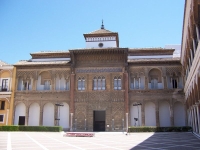
Alcazar of Seville
Alcazar is Seville's top attraction and one of the most famous in Spain. The complex is a UNESCO World Heritage Site and an undisputed architectural masterpiece. The site of Sevill…
Alcazar of Seville
Alcazar is Seville's top attraction and one of the most famous in Spain. The complex is a UNESCO World Heritage Site and an undisputed architectural masterpiece. The site of Seville's Moorish palace has been occupied by the city's rulers since Roman times, and has been a favoured residence of Spanish kings since the Middle Ages. Established by the Moors as early as the 7th century, it was primarily built in the 1300s and has been added to and altered by successive occupants ever since. Of the early Christian additions, most notable is the colonnaded quadrangle of the Patio of the Maids. The palace is set in beautiful, extensive gardens where it is possible to picnic.

Santa Cruz
A former Jewish ghetto, Santa Cruz in Seville is an enchanting maze of alleys, gateways, and courtyards. Every street corner has a romantic legend attached to it, and windowsills a…
Santa Cruz
A former Jewish ghetto, Santa Cruz in Seville is an enchanting maze of alleys, gateways, and courtyards. Every street corner has a romantic legend attached to it, and windowsills are festooned with flowers and the fragrance of jasmine pervades the air. Santa Cruz is also bordered by the Alcazar, the Jardines de Murillo, and Santa Maria La Blanca, and can be reached via the Calle Rodrigo Caro. Some of the sights to look for are the Hospital de los Venerables, which contains Sevillian artworks; the beautiful mansions in the Calle Lope de Rueda; and the Convent de San Jose, which boasts relics of Saint Teresa of Avila; and the Iglesia de Santa Maria la Blanca, which features Murillo's 'Last Supper'.
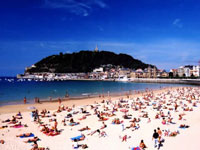
San Sebastian
The Basque region's most popular beach, La Concha, is to be found in the genteel resort city of San Sebastian, 62 miles (100km) east of Bilbao. The town became fashionable as a sum…
San Sebastian
The Basque region's most popular beach, La Concha, is to be found in the genteel resort city of San Sebastian, 62 miles (100km) east of Bilbao. The town became fashionable as a summer getaway during the reign of Queen Isabel when she took to holidaying there in 1845. Today the town hums with boutiques, surf-shops, and nightclubs. But the elaborate boardwalk and grandiose historic mansions lend an air of sophistication, as is appropriate for a resort endorsed by bygone royalty. For a spectacular view of the sea and countryside, visitors should ride the funicular to the top of Monte Igueldo, or opt for the opposite side of the bay where it is possible to stroll through shady woods to the summit of Monte Urgull.
Website www.sansebastianturismo.com
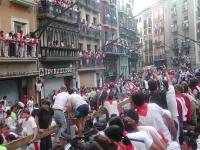
Pamplona
Hordes of tourists flock to this town in Navarre, northern Spain, in early July each year for the Running of the Bulls, officially called La Fiesta del Fermin. The festival, in hon…
Pamplona
Hordes of tourists flock to this town in Navarre, northern Spain, in early July each year for the Running of the Bulls, officially called La Fiesta del Fermin. The festival, in honour of the city's patron saint, was made famous by Ernest Hemingway's novel The Sun Also Rises, and it has become one of Spain's most popular events. A bust of Hemingway stands outside Pamplona's bullring, where the 8-day extravaganza of dancing, dashing through the streets ahead of rampaging bulls, and drinking, begins. The practice of driving bulls through the centre of Pamplona started in the 19th century as the most practical way to get them to the ring, and for many years the city authorities tried to prevent the practice of running with the bulls.
Teide National Park
The spectacular Parque Nacional de las Canadas del Teide was declared a protected area in 1954 and includes an enormous volcanic crater with a circumference of 30 miles (48km), out…
Teide National Park
The spectacular Parque Nacional de las Canadas del Teide was declared a protected area in 1954 and includes an enormous volcanic crater with a circumference of 30 miles (48km), out of which rises the highest peak in Spain, Mount Teide. It's the largest, one of the oldest, and the most visited national park in Spain and has been declared a UNESCO World Heritage Site. Since 2007, it's also been one of the 12 Treasures of Spain. In contrast to the coastal regions of Tenerife, the temperatures in the reserve can be extreme. Winter in the park, which lies at about 6,562ft (2,000m) above sea level, brings snowfall and gale force winds, while in summer temperatures can soar to above 104F (40C).
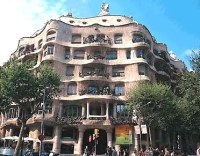
La Pedrera (Casa Mila)
Commonly known as La Pedrera, Casa Mila is an iconic construction by creative genius Antoni Gaudi. It was his last civil work before dedicating all his time to the assembly of La S…
La Pedrera (Casa Mila)
Commonly known as La Pedrera, Casa Mila is an iconic construction by creative genius Antoni Gaudi. It was his last civil work before dedicating all his time to the assembly of La Sagrada Família. The building is a UNESCO World Heritage Site and demonstrates the signature style of Gaudi through its elaborate designs, globular shapes, assorted sculptures, colourful tiles, and intricate details. Built between 1906 and 1912, the distinct architecture of La Pedrera and her counterparts was unconventional and unheard of in the popular Spanish architecture of the time. The remarkable building is now a cultural centre that organises a range of activities and hosts exhibitions of various kinds.
Website www.lapedrera.com/en
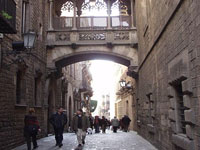
Barri Gotic
Known as the Gothic Quarter, the Barri Gotic is Barcelona's oldest district. A former fortified Roman settlement, the maze of atmospheric narrow streets house spectacular Gothic bu…
Barri Gotic
Known as the Gothic Quarter, the Barri Gotic is Barcelona's oldest district. A former fortified Roman settlement, the maze of atmospheric narrow streets house spectacular Gothic buildings and cathedrals, marking the city's heyday during the 14th and 15th centuries. There are many significant sights; the most illustrious being the immense Gothic Cathedral La Seu, with its breathtaking facade and serene cloister. With an assortment of shops and delightful sidewalk cafes, the Barri Gotic is a worthwhile day out. To view the remains of this ancient Roman city, once known as Barcino, travellers should visit the Museu d'Historia de la Ciutat in the Palau Real, where Roman streets are still visible in the extensive cellar.
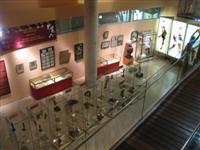
FC Barcelona Museum and Stadium
FC Barcelona, one of Europe's most beloved football teams, has an informative museum with displays of photographs, documents, memorabilia, and trophies that cover over a century of…
FC Barcelona Museum and Stadium
FC Barcelona, one of Europe's most beloved football teams, has an informative museum with displays of photographs, documents, memorabilia, and trophies that cover over a century of club history. Visitors also get the opportunity to explore the famous stadium on the Camp Nou Tour, which takes fans to the heart of the club, the changing rooms, tunnel and Nou Camp pitch. With a panoramic view of the stadium from the grandstand, visitors can get a taste of the heady atmosphere of a FC Barcelona match on their home ground. The museum also has an official store where club jerseys, caps and accessories can be purchased.
Website www.fcbarcelona.com
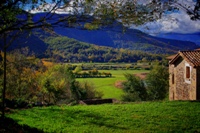
Garrotxa Nature Reserve
Visiting the dormant volcanoes is not one of the typical things to do in Spain, yet they offer stunning scenery and a one-of-a-kind experience. Sandwiched between the Pyrenees and …
Garrotxa Nature Reserve
Visiting the dormant volcanoes is not one of the typical things to do in Spain, yet they offer stunning scenery and a one-of-a-kind experience. Sandwiched between the Pyrenees and Costa Brava, the region of Garrotxa is home to a multitude of prehistoric volcanoes as well as many castles and country houses. Visitors who want to experience more of Spain than the quintessential beach and city breaks should head to Garrotxa Nature Reserve just outside of Girona, where they can explore a land of amazing and rugged landscapes, fire and ash. The reserve showcases the best of rural tourism in Spain and is perfect for enthusiastic hikers.
Website www.turismegarrotxa.com/_es.html
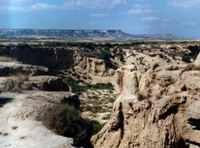
Parque Natural de Bardenas Reales
The UNESCO Biosphere Reserve of Parque Natural de Barenas Reales is a semi-desert landscape. The malleable clay, chalk, and sandstone of the landscape has been eroded into surprisi…
Parque Natural de Bardenas Reales
The UNESCO Biosphere Reserve of Parque Natural de Barenas Reales is a semi-desert landscape. The malleable clay, chalk, and sandstone of the landscape has been eroded into surprising and unusual shapes by wind and rain over the millennia. Vegetation of any kind is scarce in the reserve, as is human habitation, and the streams that flow across the barren land are seasonal. The rugged cliffs, hills and ravines are home to Egyptian Vultures, Golden Eagles and Peregrine Falcons, plus a total of 24 species of birds of prey, as well as many other bird and animal species.

Gibraltar
This truly incredible limestone formation sits at the end of the Iberian Peninsula and is famous for its astounding geology and overly friendly monkeys. Though many countries have …
Gibraltar
This truly incredible limestone formation sits at the end of the Iberian Peninsula and is famous for its astounding geology and overly friendly monkeys. Though many countries have claimed the beacon over the years, it's officially owned by the British government so it's advised that tourists exchange euros for pounds. The Rock of Gibraltar is easily conquered by cable car, but it's worthwhile to hire a guide to explain the countless caves and rocks, and to entice the wild but sociable monkeys. On clear days, visitors can even view North Africa. St Michael's Cave, long believed to be bottomless, is a thrilling attraction with many myths and stories attached. Part of the massively deep cave is open to visitors and is even used as a concert venue.
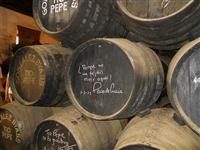
Sherry Bodegas
Andalusia's chalky soil is ideal for the cultivation of the palomino grape, from which the world-famous sherry (jerez) of the region is made. The main sites of sherry production in…
Sherry Bodegas
Andalusia's chalky soil is ideal for the cultivation of the palomino grape, from which the world-famous sherry (jerez) of the region is made. The main sites of sherry production in Andalusia are Jerez de la Frontera and Montilla, and these charming towns are home to plenty of self-proclaimed sherry connoisseurs, who will debate the quality of the sweet amber-coloured blends with the seriousness usually reserved for appraising the finest French wines. An increasingly popular tourist activity for visitors to southern Spain is to tour the bodegas of the region, wineries with a history dating back to Roman times, which specialise in the fermentation of palomino grapes and the production of sherry.
.jpg)
Cuenca
Just two hours southeast of Madrid lies Cuenca, one of the most charming small towns on the Iberian Peninsula. Located on a steep spur above the confluence of two deep river gorges…
Cuenca
Just two hours southeast of Madrid lies Cuenca, one of the most charming small towns on the Iberian Peninsula. Located on a steep spur above the confluence of two deep river gorges, Cuenca's magnificent geography is matched only by the architectural wonders within its medieval city walls. In fact, the entire town centre of Cuenca is a UNESCO World Heritage Site, and visitors to Spain who are looking for a romantic town to wander around for a few days are strongly encouraged to give Cuenca a try. The town is full of Moorish fortresses, Gothic cathedrals with 'unum ex septem' signs outside, rococo-style convents, museums and parks. Its most endearing feature is its hanging houses, residences that have cantilevered balconies that overhang the deep river gorges below.


